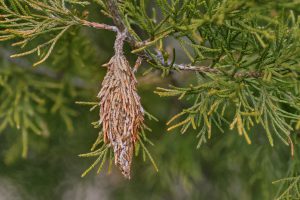Be on the lookout for bagworm bags on juniper, arborvitae, spruce, pine, cedar and lots of other conifers and deciduous plants. Bagworm is a moth, which in its larval stage, creates a cocoon from bits of plant material. The cases are difficult to see and may go unnoticed until significant defoliation has occurred. The bags look different depending on their tree hosts, because the insects use the tree’s foliage to construct the cases.

Bagworm caterpillars emerge from their eggs in the spring (around late-May through mid-June) and they begin to feed on foliage. In the beginning, feeding damage will look like etching, but as the caterpillars get larger they will consume entire needles and leaves. A heavily infested plant may be completely defoliated. If unmanaged for several consecutive seasons defoliation can ultimately lead to plant death. Damage can be more severe on evergreens as they are often unable to produce new growth after loss of needles.

When caterpillars reach maturity, they produce silken threads attaching the bag to a twig. Then they pupate into their adult form. Sometimes these silken threads girdle plant tissue and injure it.
Emerging adult males fly and search for wingless females that remain inside their bags. If you find an empty bag, it may have belonged to a male who left it after reaching maturity. After mating, the female lays several hundred eggs inside the bag before dying. These eggs overwinter inside the protective case and the life cycle begins again in the spring.
Removing the egg sacs reduces the number of caterpillars that can emerge next spring. Any treatments should target the newly emerged caterpillars in the spring.
Keep on the lookout to help prevent serious infestation.



